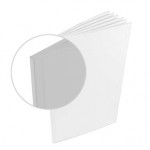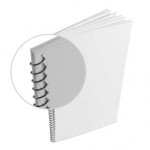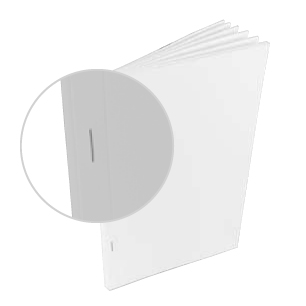Technical Information
What is Direct-to-plate [digital] printing?
Digital printing is not an ink-on-paper process; it’s a toner-on-paper process. The toner lays on top of the paper, whereas ink soaks into the paper with offset printing. Digital printing can be faster than offset printing because it eliminates the step of producing film, and drying time isn’t necessary because there is no ink involve. The job can get pulled off the presses and into the finishing stages immediately. However, since digital printing is not an ink-on-paper process, the look and feel of a digitally printed piece will not be the same as a project printed on an offset machine. For example, if you plan to print solids over a fold or spine, the toner may flake off. Talk to your printer about what to expect, and ask for samples of their work on the paper stock you intend to use.
If you’re producing a project that requires variable data, such as the personalization of direct mail pieces, digital printing is a great tool to accomplish your goals.
It’s also possible to print a job using a combination of offset and digital printing. This creates a whole new set of opportunities and challenges.
Benefits of Digital Printing
- Cost-effective for short runs (less than 1000)
- Fast
- Variable data capability on some presses
Disadvantages of Digital Printing
The print techniques you may be used to with an offset press may vary with digital equipment. Here are some highlights.
- Looking for a full bleed? You’ll need a larger sheet. Toner won’t extend off the edges. For example, if you want to print a full bleed on an 8.5 x 11.5 sheet, you’ll need to print your image on a larger sized sheet and trim it down.
- Thin lines or small type reproduced in color may not print as well on digital presses as on offset presses because registration is not always exact. Avoid knock-out type.
- Digital equipment does not offer spot colors or special finishing techniques such as varnishes.
- Large blocks of solid may present problems such as flaking and banding.
- Not as exact in reproducing match colors.
- Screen (match colors printed at less than 100%) may appear pixelized.
What is Perfect Binding?
Perfect Binding
The spine or the book is cut and roughened, adhesive is applied to the rough edges and a cover is glued firmly in place. Bleeds and crossovers are also handled differently on perfect bound books.
- Versitile
- Overall look and visual appeal
- Printable spine
- Longevity
- Ability to creatively interleaf pages
Limitations
- Doesn’t lay flat. Not suggested for applications in which hands-free reading isimportant [e.g. cookbooks, technical guides, directories or instruction manuals].
- Minimum thickness of 1⁄8″ inch needed if spine is printed or1⁄16inch if spine isn’t printed.
THE PROCESS
- Folded signatures or single leaves are gathered into a stack.
- The spine side of the stack is milled to remove the folded edges, and roughened toexpose the paper fibers. The edge of each page is left exposed.
- Hot melt adhesive is applied along the spine edge of the book. The glue does notpenetrate; it flows around the exposed fibers.
- The cover is applied to the spine while the glue is hot. It is then pressed onto thespine, and wrapped around the book block.
- Hot melt dries in 2 to 25 seconds.
- The book is run through a three knife trimmer to trim the face, the head and the foot.
What is Spiral Binding?
Spiral Stitching
To bind using a spiral of continuous wire or plastic looped through punched holes.
- Versatile & widely available
- Almost any material can be punched and bound, including paper, plastic and laminates.
- Lays flat.
- Ability to creatively interleaf pages.
- Finished piece folds over 360 degrees [useful for technical and reference applications].
- Well suited for short runs.
- Can accommodate grain short and most paper weights.
Limitations
- Not as sturdy as double loop wire.
- If the wire is crushed, it will not return to its original shape.
- Pages will jog when open and pages will step up when turned. Crossover designs willnot align.
- Wire ends are left unfinished; may snag or pull.
THE PROCESS
- Holes are drilled or punched.
- Continuous spiral wire is fed into the holes sequentially.
- Wire is crimped on both ends to prevent unravelling.
What is Side Stitch Binding?
Stapling the signatures together on the side rather than the fold.
Advantages
- Versitile & widely available
- Almost any material can be punched and bound, including paper, plastic and laminates.
- Lays flat.
- Ability to creatively interleaf pages.
- Finished piece folds over 360 degrees [useful for technical and reference applications].
- Well suited for short runs.
- Can accommodate grain short and most paper weights.
Limitations
- Not as sturdy as double loop wire.
- If the wire is crushed, it will not return to its original shape.
- Pages will jog when open and pages will step up when turned. Crossover designs willnot align.
- Wire ends are left unfinished; may snag or pull.
THE PROCESS
- Loose pages are collated and assembled into a stack.
- The loose pages are stitched or stapled parallel to the spine.
- When binding signatures, the head, foot and face of the book are trimmed.


